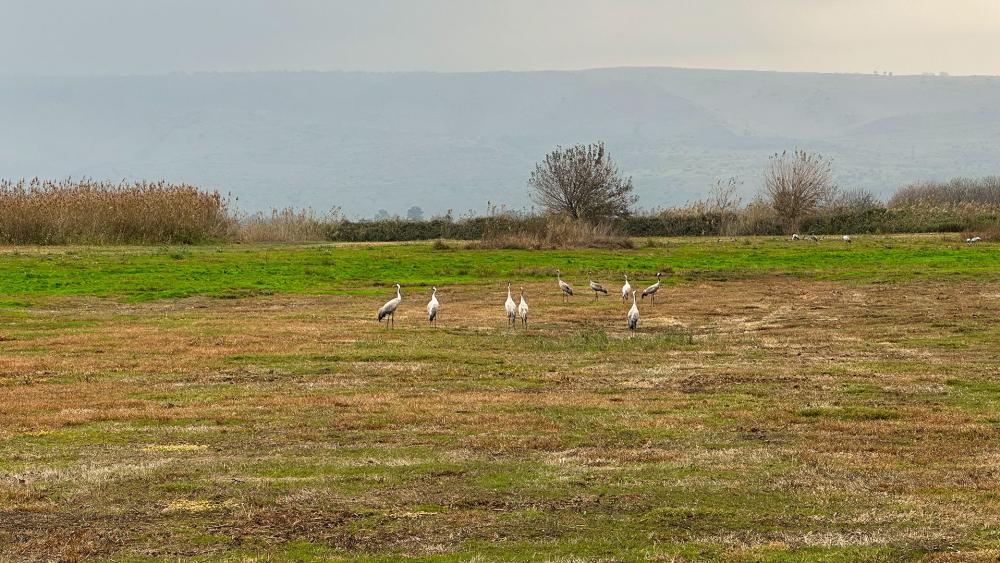HULA VALLEY, Northern Israel – While Israelis have suffered in many ways for more than 16 months, so have the country's forests and animals. CBN News traveled north to visit an important park that reopened after more than a year.
Less than 20 miles from the Lebanese border, Agamon HaHula Park is known as a bird-watcher's paradise.
In good times the Hula Valley can host millions of migrating birds and thousands of visitors each year.
Closed since October 2023, it's been very quiet, with no statistics on how the war affected the bird migration. Now, things are looking up.
After more than a year of being closed down due to war, missiles, and forest fires, the Agamon HaHula Park is now ready to re-open, and welcome visitors from within Israel and around the world.
Ifat Ovadia-Luski of the KKL-Jewish National Fund oversees Israel's forests and is helping to rebuild communities here.
She told CBN News, "It symbolizes the rehabilitating of the north of Israel and the coming back home of the citizens that (were) supposed to have left in the middle of the night, one year ago."
Ovadia-Luski is convinced that although northern Israel has never experienced anything like the devastation of the war, hope is strong.
"We have the evacuees, people, and the fires, and this site was closed more than a year,
she noted. "It means that thousands of visitors couldn't come here."
We joined a tour of the affected areas recently. The park's visitor center contains interactive exhibits and offers an option to walk or tour the grounds in a vehicle.
The war throughout northern Israel damaged around 5,000 acres of forests.
Dr. Doron Markel, the park's chief scientist, told us, "We had a lot of streams and springs, aquatic environments that were polluted, and open areas that were polluted by oil and benzene, you know, from the army vehicles. In the forest that was burned, we saw that animals were hurt."
Markel says although they don't know how the birds coped with the war overall, the cranes seem to be doing well.
"There are thousands of cranes wintering here, as usual. And even more than last year. So, nature wins it all," he said.
Itamar Katz, head forester of the Golan Heights, says the war has kept his crews busy.
"More than a third of all of our forests burned," he explained. "If we talk about open areas, we're talking four times what I just said."
Sadly, the biggest culprit behind the forest fires, according to Katz, has been Israel's interceptor rockets," programmed to shoot down the large volleys of incoming missiles from Israel's enemies.
"They created so many fires," Ovadia-Luski remarked. "I mean, they saved countless amounts of lives. But if we were used to getting one rocket fall in one forest and start one fire, then you had 3 or 4 interceptors which started 20 or 30 spot fires. It was a very different situation."
It often prevented them from doing their job.
"We weren't always allowed to go to the fire at the end of the day. And sometimes we were just told, listen, it's too dangerous. It's too close to the border. And we just needed to let it burn." Ovadia-Luski added.
***Please sign up for CBN Newsletters and download the CBN News app to ensure you receive the latest news from a Christian Perspective.***
Head veterinarian Rona Nadler-Valency started to treat animal patients primarily injured by human presence when the Agamon Wildlife Rehabilitation Center opened about five years ago.
"So, it can be road traffic accidents, and it can be collisions with power lines, can be poison from agriculture from various other things. It can also be gunshot wounds. We take in patients that have been injured, and we nurse them and rehabilitate them back, and release them to nature," she explained.
Before the war, the center had been growing.
"And then the war kicked in, and we had to learn how to work in a very different reality," Nadler-Valency noted. "So in the beginning, all of our staff, including myself, we had to evacuate because we were all from here, from the Galilee.."
Thus, The center had to close.
Nadler-Valency added, "In fact, we had to release all of the animals and hope for the best, but eventually we just came back because we really needed to be here for the animals."
When they reopened, they didn't see many patients because there were no people to bring in the animals – only soldiers in the war zones found them.
"We saw a lot of injuries that are related to the war," the veterinarian said. "So (we would see) collisions with army vehicles or animals entrapped in fire zones."
Now, the KKL-Jewish National Fund is shifting gears, looking toward the future. Nadler-Valency said they hope to build a new animal hospital, "so that we can have an impact – a greater impact – and take in more patients and treat more animals every year, and release them back to nature."
Dr. Markel told us the reopening of the visitor center is an important step.
"It can be a day of change, a day that we will start the reclamation and rehabilitation – not only of people but also nature. The key here is to study before you do. And when you do, you do it better. We call it 'build back better,'" he said.
Did you know?
God is everywhere—even in the news. That’s why we view every news story through the lens of faith. We are committed to delivering quality independent Christian journalism you can trust. But it takes a lot of hard work, time, and money to do what we do. Help us continue to be a voice for truth in the media by supporting CBN News for as little as $1.












 Support CBN News
Support CBN News







